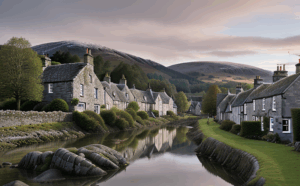Early Friday morning, Comrie residents experienced a sudden and unexpected tremor, jolting many awake. The shaking, described by some as feeling like a powerful quarry blast, lasted only a short time but left a lasting impression on the community.
The British Geological Survey (BGS) confirmed the event, registering it as a micro-earthquake measuring 1.0 on the Richter scale. This relatively low magnitude tremor occurred approximately 2 kilometers beneath the village’s surface at roughly 4:55 am. While the intensity was minor, the early hour and the unusual nature of the event caught many off guard. Comrie’s Seismic History
Comrie, famously known as the “Shaky Toun,” boasts a long and well-documented history of seismic activity. Situated near the Highland Boundary Fault, a significant geological feature extending through Scotland, the area is known for its susceptibility to earthquakes, both minor and, on occasion, more substantial. This latest event adds another chapter to the fascinating history of this unique Perthshire village.
Local residents recounted the experience, sharing their stories of being startled awake by what sounded like a powerful explosion. The unexpected nature of the event, combined with its unique auditory qualities, created a memorable experience for the community, generating conversations and discussions about Comrie’s reputation.
The BGS reports that, despite the low magnitude, the tremor was indeed noticeable to several Comrie residents. This isn’t unusual, as even minor tremors can produce noticeable effects, especially those occurring at a relatively shallow depth. The proximity of the earthquake’s epicenter to the village’s homes and buildings likely amplified the sensation for local inhabitants. The Earthquake House
For over 150 years, Comrie has been home to the renowned “Earthquake House.” This historic building, diligently maintained by the local community, serves as a testament to the village’s unique relationship with seismic activity. The Earthquake House serves not only as a historical landmark but as a valuable scientific resource that helps researchers keep track of tremors, providing data that contributes to seismic research. The dedication of the people of Comrie to preserving the structure speaks volumes about their deep connection to their heritage.
The precise location of the recent tremor within close proximity to the village underscores Comrie’s position in a seismically active zone. While earthquakes of this magnitude typically pose no significant structural risk, it highlights the ongoing geological processes influencing the Perthshire landscape. Residents continue to feel the impact, both literally and figuratively, of living in an area with a dynamic geological history.
The event serves as a reminder of the constant geological activity shaping the region, and it brings to light the importance of community knowledge and historical context in interpreting such events. The “Earthquake House” exemplifies not only a remarkable piece of local heritage but also a crucial record of the geological forces that continue to define the area. Many visitors come to witness this special aspect of Comrie, and the local residents work tirelessly to maintain it.
Beyond the earthquake, Perth and Kinross has experienced a variety of noteworthy events recently, including [mention a local event, for example: the Perthshire Agricultural Show, a local music festival, a community initiative]. These events contrast sharply with the unusual occurrence of the earthquake but showcase the diverse and vibrant aspects of life in the region. The community’s resilience and ability to adapt to such varied circumstances is indeed remarkable.
The BGS continues to monitor seismic activity across Scotland. While micro-earthquakes are a common occurrence, they often serve as valuable reminders of the powerful geological forces underlying our lives and landscape. For those interested in learning more about earthquakes and seismic activity in Scotland, the BGS website offers a wealth of readily accessible information.
For Perth and Kinross residents, this most recent experience is a unique and memorable event adding to Comrie’s already rich history. The resilience of the community, coupled with their pride in their village’s unique status, is evident in their ongoing dedication to preserving their history and heritage amidst occasional natural disturbances. The continued operation of the Earthquake House shows the deep connection Comrie’s people have to their unique heritage.
The British Geological Survey (BGS) confirmed the event, registering it as a micro-earthquake measuring 1.0 on the Richter scale. This relatively low magnitude tremor occurred approximately 2 kilometers beneath the village’s surface at roughly 4:55 am. While the intensity was minor, the early hour and the unusual nature of the event caught many off guard. Comrie’s Seismic History
Comrie, famously known as the “Shaky Toun,” boasts a long and well-documented history of seismic activity. Situated near the Highland Boundary Fault, a significant geological feature extending through Scotland, the area is known for its susceptibility to earthquakes, both minor and, on occasion, more substantial. This latest event adds another chapter to the fascinating history of this unique Perthshire village.
Local residents recounted the experience, sharing their stories of being startled awake by what sounded like a powerful explosion. The unexpected nature of the event, combined with its unique auditory qualities, created a memorable experience for the community, generating conversations and discussions about Comrie’s reputation.
The BGS reports that, despite the low magnitude, the tremor was indeed noticeable to several Comrie residents. This isn’t unusual, as even minor tremors can produce noticeable effects, especially those occurring at a relatively shallow depth. The proximity of the earthquake’s epicenter to the village’s homes and buildings likely amplified the sensation for local inhabitants. The Earthquake House
For over 150 years, Comrie has been home to the renowned “Earthquake House.” This historic building, diligently maintained by the local community, serves as a testament to the village’s unique relationship with seismic activity. The Earthquake House serves not only as a historical landmark but as a valuable scientific resource that helps researchers keep track of tremors, providing data that contributes to seismic research. The dedication of the people of Comrie to preserving the structure speaks volumes about their deep connection to their heritage.
The precise location of the recent tremor within close proximity to the village underscores Comrie’s position in a seismically active zone. While earthquakes of this magnitude typically pose no significant structural risk, it highlights the ongoing geological processes influencing the Perthshire landscape. Residents continue to feel the impact, both literally and figuratively, of living in an area with a dynamic geological history.
The event serves as a reminder of the constant geological activity shaping the region, and it brings to light the importance of community knowledge and historical context in interpreting such events. The “Earthquake House” exemplifies not only a remarkable piece of local heritage but also a crucial record of the geological forces that continue to define the area. Many visitors come to witness this special aspect of Comrie, and the local residents work tirelessly to maintain it.
Beyond the earthquake, Perth and Kinross has experienced a variety of noteworthy events recently, including [mention a local event, for example: the Perthshire Agricultural Show, a local music festival, a community initiative]. These events contrast sharply with the unusual occurrence of the earthquake but showcase the diverse and vibrant aspects of life in the region. The community’s resilience and ability to adapt to such varied circumstances is indeed remarkable.
The BGS continues to monitor seismic activity across Scotland. While micro-earthquakes are a common occurrence, they often serve as valuable reminders of the powerful geological forces underlying our lives and landscape. For those interested in learning more about earthquakes and seismic activity in Scotland, the BGS website offers a wealth of readily accessible information.
For Perth and Kinross residents, this most recent experience is a unique and memorable event adding to Comrie’s already rich history. The resilience of the community, coupled with their pride in their village’s unique status, is evident in their ongoing dedication to preserving their history and heritage amidst occasional natural disturbances. The continued operation of the Earthquake House shows the deep connection Comrie’s people have to their unique heritage.


